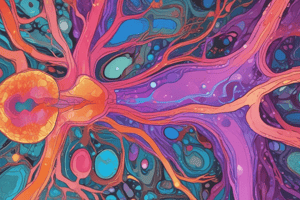Podcast
Questions and Answers
What is the main purpose of using fluorescent dyes in immunofluorescence assay?
What is the main purpose of using fluorescent dyes in immunofluorescence assay?
- To differentiate between direct and indirect immunofluorescence techniques
- To enhance the brightness of the microscope image
- To speed up the process of detecting cancer cells
- To tag antibodies and proteins, aiding in isolating desired targets (correct)
What is the key difference between direct and indirect immunofluorescence techniques?
What is the key difference between direct and indirect immunofluorescence techniques?
- Use of a single antibody coupled with a fluorophore in direct, while indirect uses two antibodies to bind to the target protein (correct)
- Direct technique requires higher concentration of antibodies than indirect technique
- Indirect technique is more cost-effective than direct technique
- Direct technique allows simultaneous detection of multiple proteins, while indirect does not
In which field can immunofluorescence assay be particularly useful for studying brain function and diseases?
In which field can immunofluorescence assay be particularly useful for studying brain function and diseases?
- Pharmacology
- Endocrinology
- Neurology (correct)
- Oncology
How does multiplex immunofluorescence technique differ from direct and indirect techniques?
How does multiplex immunofluorescence technique differ from direct and indirect techniques?
What is the primary role of immunofluorescence assay in studying viral infections?
What is the primary role of immunofluorescence assay in studying viral infections?
Study Notes
Fluorescent Dyes in Immunofluorescence Assay
- The main purpose of using fluorescent dyes is to visualize and detect the presence of specific antigens or proteins in cells or tissues.
Direct and Indirect Immunofluorescence Techniques
- The key difference between direct and indirect immunofluorescence techniques is that direct immunofluorescence uses a single labeled antibody that binds directly to the antigen, whereas indirect immunofluorescence uses an unlabeled primary antibody that binds to the antigen, followed by a labeled secondary antibody that binds to the primary antibody.
Applications of Immunofluorescence Assay
- Immunofluorescence assay can be particularly useful for studying brain function and diseases, such as neurodegenerative disorders like Alzheimer's and Parkinson's, in the field of neuroscience.
Multiplex Immunofluorescence Technique
- Multiplex immunofluorescence technique differs from direct and indirect techniques in that it allows for the simultaneous detection of multiple antigens or proteins in a single sample using multiple fluorescent dyes.
Immunofluorescence Assay in Studying Viral Infections
- The primary role of immunofluorescence assay in studying viral infections is to identify and locate viral antigens in infected cells, enabling researchers to understand the viral replication cycle and develop diagnostic and therapeutic strategies.
Studying That Suits You
Use AI to generate personalized quizzes and flashcards to suit your learning preferences.
Description
Discover the principles of immunofluorescence, a powerful technique in scientific research and medical diagnostics. Learn about the use of specific antibodies, fluorescent dyes, and microscopy to visualize proteins of interest.




